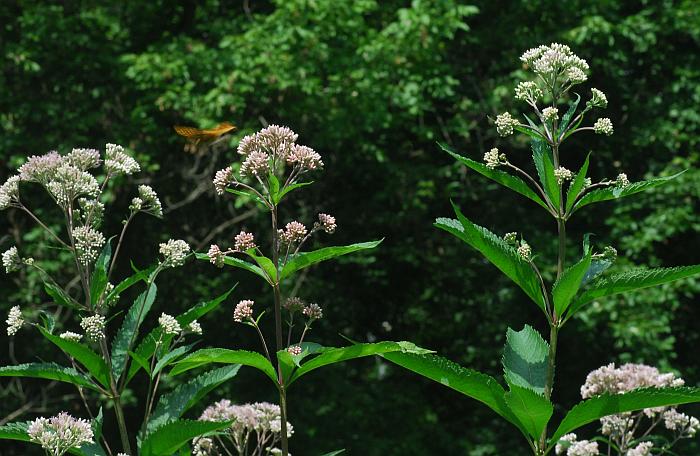Eutrochium maculatum (L.) E.E. Lamont
Spotted Joe-Pye Weed

Native
CC = 10
CW = -5
MOC = 3
SRank = S1
© SRTurner
Eutrochium maculatum (L.) E.E. LamontSpotted Joe-Pye Weed | |
 |
Native CC = 10 CW = -5 MOC = 3 SRank = S1 |
© SRTurner |
|
Family - Asteraceae/Eupatorieae Habit - Fibrous rooted perennial forb, usually with rhizomes. Stem - Ascending to erect, to 2 m, solid or hollow near the base, mottled with purple, usually moderately short-hairy, usually lacking axillary branches or leaf fascicles.
Leaves - Simple, petiolate, mostly in whorls of 4 or 5, the petiole 2-25 mm long. Blades 5-20 cm long, 15-70 mm wide, lanceolate to ovate, narrowed or tapered at the base, tapered to a sharply pointed tip, the margins sharply toothed, the upper surface glabrous to moderately short-hairy or roughened, the undersurface densely short-hairy, also glandular, with 1 main vein.
Inflorescences - Terminal panicles, often large, usually flat-topped or nearly so, sometimes the individual branches flat-topped and the entire panicle broadly dome-shaped.
Heads - Involucre 6.5-9.0 mm long, narrowly cup shaped, the bracts ovate to lanceolate or narrowly oblong-elliptic, rounded to less commonly bluntly pointed at the tip, often 3-nerved, often minutely hairy, usually purplish-tinged to dark purple.
Florets - Disc florets 8-22. Corollas 4.5-7.5 mm long, the surface often somewhat glandular, mostly pale purple or purplish-tinged. Ray florets absent.
Fruits - Achenes 3.0-4.5 mm long. Flowering - July - September. Habitat - Fens, especially shakey spring fens, marsh edges. Origin - Native to the U.S. Lookalikes - Other species of Eutrochium, especially E. fistulosum. Other info. - This species is rare in Missouri, known so far from specialized habitats in only three counties. It was first reported from the state from a deep muck fen in 1987. it is more common in regions to our north and, oddly, southwest. The North American distribution is strongly tied to infraspecific form. Missouri plants are assigned var. bruneri, which has densely pubescent stems and leaf undersurfaces, and which ranges farthest to the west. The var. maculatum is characterized by sparsely hairy to nearly glabrous leaf undersurfaces and stems (below the inflorescences), and is common in the upper Midwest and Northeast, and into Canada. The far northeastern var. foliosum (Fernald) Wiegand has pubescence similar to that of the typical variety but differs in having the uppermost leaves relatively unreduced and mostly surpassing the inflorescence. Photographs taken at the Busch / Duckett Creek Greenway, St. Charles County, MO, 8-5-2014, and in Fremont, Newaygo County, MI, 8-30-2014 (SRTurner). |